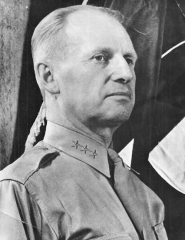Lesley McNair

Lesley McNair
LESLEY
MCNAIR
SOLDIER DETAILS
BIOGRAPHY
McNair was born in Verndale, Minnesota, on May 25, 1883, the son of James and Clara (Manz) McNair. He was the second-born of their six children. McNair attended school in Verndale through the ninth grade, the highest available locally; his parents then relocated to Minneapolis so McNair and his siblings could complete high school. After graduating from South High School in 1897, he competed successfully for an appointment to the United States Naval Academy. While he was on the Naval Academy waiting list as an alternate, he began studies at the Minnesota School of Business in Minneapolis, where he concentrated primarily on mechanical engineering and statistics courses. Frustrated with the wait to start at the Naval Academy, in 1900 McNair competed for appointment to the United States Military Academy. Initially selected as an alternate in July 1900, he was quickly accepted as a member of the class that began that August. While at West Point, his fellow students nicknamed him "Whitey" for his ash blond hair; they continued to use it with him for the rest of his life. The description of McNair which accompanied the photo of him in West Point's yearbook for his senior year refers to him as "Pedestrian Whitey" and details an incident when he had to walk from Newburgh to West Point, a distance of 11 miles (18 km), after having missed the last train while returning from visiting his fiancée in New York City. McNair graduated in 1904, and was commissioned as a second lieutenant. The top five or six graduates usually chose the engineer branch; McNair's high class standing (11th of 124) earned him a place in the second choice of most high-ranking graduates, the artillery branch. McNair was first assigned as a platoon leader with the 12th Battery of Mountain Artillery at Fort Douglas, Utah. While there, he requested duty with the Ordnance Department, and passed a qualifying examination. After approval of his transfer request, he was first assigned to Sandy Hook Proving Ground, New Jersey, where he began a lifelong interest in testing and experimenting with new equipment and weapons. World War I he served as assistant chief of staff for training with the 1st Division, and then chief of artillery training on the staff at the American Expeditionary Forces headquarters. His outstanding performance resulted in his promotion to temporary brigadier general; at age 35, he was the Army's second-youngest general officer. McNair's experience of more than 30 years with equipment and weapons design and testing, his administrative skills, and his success in the areas of military education and training led to his World War II assignment as commander of Army Ground Forces. In this position, McNair became the "unsung architect of the U.S. Army", and played a leading role in the organizational design, equipping, and training of Army units in the United States before they departed for overseas combat. While historians continue to debate some of McNair's decisions and actions, including the individual replacement system for killed and wounded soldiers, and a controversy over the use of tanks or tank destroyers as anti-tank weapons, his concentration on advanced officer education, innovative weapons systems, improved doctrine, realistic combat training, and development of combined arms tactics enabled the Army to modernize and perform successfully on the World War II battlefield, where the mobility of mechanized forces replaced the static defenses of World War I as the primary tactical consideration. He was killed by friendly fire while in France to act as commander of the fictitious First United States Army Group, part of the Operation Quicksilver deception that masked the actual landing sites for the Invasion of Normandy. McNair is buried in Normandy. Courtesy of Wikipedia.
 Eisenhower Foundation
Eisenhower Foundation
